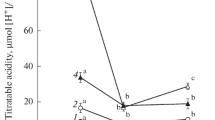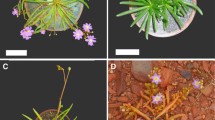Summary
Evidence for the operation of CAM in the deciduous climber, Cissus trifoliata L., was obtained in field and laboratory studies. Under natural conditions, diurnal oscillations of titratable acidity and colorimetric measurements of night CO2 fixation, determined for a period of two and a half years, suggested that acid accumulation was related to plant water status, assessed through the daily courses of stomatal resistance and xylem water potential during dry and rainy seasons. These findings were confirmed by gas exchange studies under controlled conditions which showed that the plant fixed all its CO2 during the day when it was well irrigated; as water stress increased, dark CO2 uptake gradually replaced fixation during the day until the plant only performed dark fixation. In severe water stress, even the rate of the latter process decreased until leaves fell.
Similar content being viewed by others
Abbreviations
- CAM:
-
Crassulacean acid metabolism
- FW:
-
leaf fresh weight
- SWC:
-
relative soil water content
- PAR:
-
photosynthetically active radiation
- TR:
-
total radiation; r, leaf diffusive resistance
- WSD:
-
water saturation deficit (leaf-air vapour concentration difference)
- RWC:
-
relative water content of leaves
References
Bartholomew B (1973) Drought response in the gas exchange of Dudleya farinosa (Crassulaceae) grown under natural conditions. Photosynthetica 7:114–120
Čatský J, Lake JV, Begg JE, Voznesenskii VL (1971) Physicochemical measurements of pCO2 and chemical determination of carbon dioxide. In: Sesták Z, Čatský J, Jarvis PG (eds). Plant Photosynthetic Production. A Manual of Methods. Chap. 4, Part 4.3.2. W. Junk, The Hague, pp 211–224
Cliford B, Williams GJ (1978) Temperature and water regulation of gas exchange of Opuntia polyacantha. Oecologia (Berlin) 40:331–350
De Luca P, Alfani A, Virzo de Santo A (1977) CAM, transpiration, and adaptive mechanisms to xeric environments in the succulent Cucurbitaceae. Bot Gaz 138:474–478
Hanscom Z, Ting IP (1978) Irrigation magnifies CAM-photosynthesis in Opuntia basilaris. Oecologia (Berlin) 33:1–15
Hartsock TL, Nobel PS (1976) Watering converts a CAM plant to daytime CO2 uptake. Nature 262:574–576
Kluge M (1976) Crassulacean Acid Metabolism (CAM): CO2 and water economy. In: Lange OL, Kappen L, Schulze E-D (eds) Water and Plant Life. Ecological Studies 19, Part 5A. Springer, Berlin-Heidelberg-New York, pp 313–322
Kluge M, Lange OL, Eichman M von, Schmid R (1973) Diurnaler Säurerhythmus bei Tillandsia usneoides: Untersuchungen über den Weg des Kohlenstoffs sowie die Abhängigkeit des CO2-Gaswechsels von Lichtintensität, Temperatur und Wassergehalt der Pflanze. Planta 112:357–372
Kluge M, Ting IP (1978) Crassulacean Acid Metabolism. Analysis of an Ecological Adaptation. Ecological Studies. 30. Springer, Berlin-Heidelberg-New York
Krenzer E, Moss D, Crookston K (1975) Carbon dioxide compensation points of flowring plants. Plant Physiol 56:194–206
Lange OL, Zuber M (1977) Frerea indica, a stem succulent CAM plant with deciduous C 3 leaves. Oecologia (Berlin) 31:67–72
Milburn TR, Pearson DJ, Ndegwe JA (1968) Crassulacean acid metabolism under natural tropical conditions. New Phytol 67:883–897
Mooney HA, Troughton JH, Berry JA (1965) Carbon isotope ratio measurements of succulent plants in Southern Africa. Oecologia (Berlin) 30:295–305
Neales TF (1973a) Effect of night temperature on the assimilation of carbon dioxide by mature pineapple plants, Ananas comosus (L.) Merr. Aust J Biol Sci 26:539–546
Neales TF (1973b) The effect of night temperature on CO2 assimilation, transpiration and water use efficiency in Agave americana. Aust J Biol Sci 26:705–714
Scholander PF, Hammel HT, Bradstreet ED, Hemmingsen EA (1965) Sap pressure in vascular plants. Science 148:339–346
Schütte KH, Steyn R, Westhuizen M van der (1967) Crassulacean acid metabolism in South African succulents: a preliminary investigation into its occurrence in various families. J Soc Afr Bot 33:107–110
Szarek SR, Ting IP (1975) Photosynthetic effeciency of CAM plants in relation to C 3 and C 4 plants. In: Marcelle R (ed). Environmental and Biological Control of Photosynthesis, pp 289–297. W. Junk, The Hague
Virzo de Santo A, Alfani A, Greco L, Fioretto A (1980) Environmental influences on CAM activity of Cissus quadrangularis. J Exp Bot 31:75–82
Walter H, Medina E (1971) Caracterización climática de Venezuela sobre la base de climadiagramas de estaciones particulares (Climatic characterization of Venezuela based on climadiagrams of particular weather stations). Bol Soc Venez Cien Nat XXIX:211–240
Winter K, Lüttge U, Winter E (1978) Seasonal shift from C 3 photosynthesis to Crassulacean acid metabolism in Mesembryanthemum crystallinum growing in its natural environment. Oecologia (Berlin) 34:225–237
Author information
Authors and Affiliations
Rights and permissions
About this article
Cite this article
Olivares, E., Urich, R., Montes, G. et al. Occurrence of Crassulacean acid metabolism in Cissus trifoliata L. (Vitaceae). Oecologia 61, 358–362 (1984). https://doi.org/10.1007/BF00379635
Received:
Issue Date:
DOI: https://doi.org/10.1007/BF00379635




